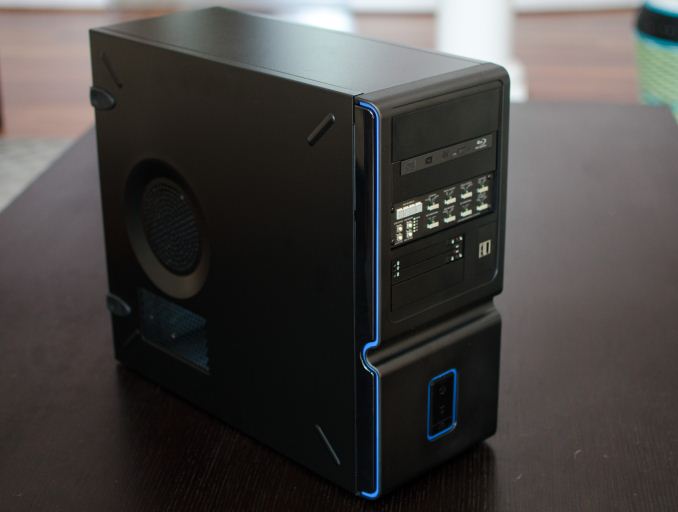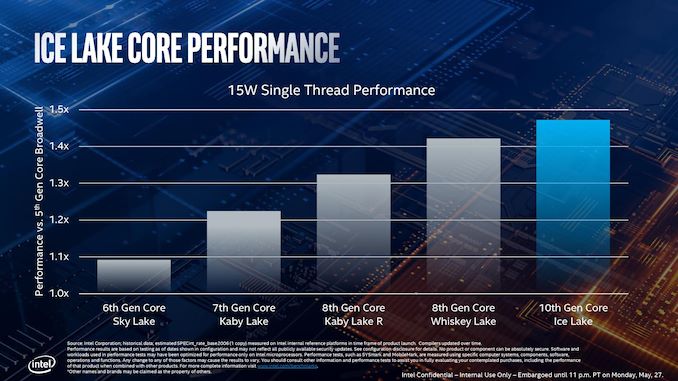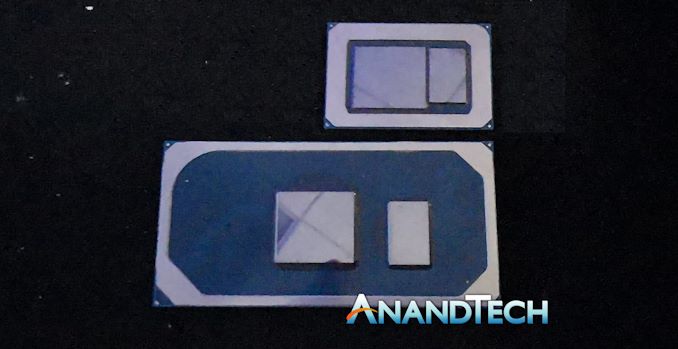The Ice Lake Benchmark Preview: Inside Intel's 10nm
by Dr. Ian Cutress on August 1, 2019 9:00 AM EST- Posted in
- CPUs
- Intel
- GPUs
- 10nm
- Core
- Ice Lake
- Cannon Lake
- Sunny Cove
- 10th Gen Core
Conclusions
First of all, I must say that Intel offering us to test a reference system in advance of a launch is a very good thing indeed. It is not something that Intel has done often in the past – in fact the last time I remember it happening was with Broadwell, when Intel sampled us one of their mobile CRB (consumer reference board) systems for the 45W chip. Before that, Intel had a small attempt allowing the press to benchmark Conroe in 2006 with canned pre-provided benchmarks, which did not go down to well. So moving into this pre-testing regime gets some immediate kudos to those who approved the testing.

Intel’s Broadwell / Crystalwell Mobile CRB
Given that the Ice Lake platform is more geared up towards ultra-premium designs, the software development system we ended up testing was certainly a reasonable expectation and direction that these parts would go in. Of course, we only had the best part of nine hours to test, and giving us the option to test both 15W and 25W modes meant we had to pick and choose what tests we thought were relevant. My most prominent feedback to Intel would be to give us two days to test next time, as it allows us to sit on our data after day one and decide what to do next. It was clear that some of the press in attendance only needed a day (or half a day), but for what we do at AT, then two days would be better.
As for Ice Lake itself, our results lean towards Ice Lake outperforming Whiskey Lake, if only by a small margin.
To preface this, I want to recall a graph that Intel showed off at Computex:
This graph shows the single thread performance of Skylake and beyond, compared to 5th Gen Broadwell hardware. Right at the very end, we see Whiskey Lake performing +42% above Broadwell, and Ice Lake performing +47% above Broadwell. A quick calculation of 1.47/1.42 means that even Intel is only predicting an absolute gain of ~3.5% for Ice Lake over current generation systems.
The reason why the difference is so small is because of IPC and frequency. Intel is touting a median IPC advantage on the new Sunny Cove cores of +18% against Skylake. That isn’t something we were able to test in the short time we had with the system, but +18% should provide a healthy bump – we actually see a number of key microarchitectural improvements bubble up through in our SPEC testing.
But at the same time, the frequency has decreased – our Whiskey Lake Huawei Matebook system was +500 MHz on the base frequency (+38%), and +700 MHz on the turbo frequency (+18%). If it were not for the vast increase in memory speed, moving from LPDDR3-2133 to LPDDR4X-3733, one might have predicted that the Core i7-1065G7 Ice Lake processor and the Core i7-8565U Whisky Lake processor would have performed equally.
The question here then becomes whether you prefer IPC or frequency. For instruction limited tasks, that answer should be IPC. For critical path limited tasks, you nominally require frequency. All this gets muddled a bit with the increased memory frequency, but with higher IPC at lower frequency, you should arguably be more power efficient as well, leading to longer battery life. At iso-performance between Ice and Whiskey, considering no other factors like price, I would choose Ice.
Intel has made a number of improvements to a chunk of the instruction set that should work well for users, however the new bigger cache design has added a bit of latency there, which ends up being a bit of give and take with cache hits and misses.
Of course, the one area where Ice Lake excels in is graphics. Moving from 24 EUs to 64 EUs, plus an increase in memory bandwidth to >50 GB/s, makes for some easy reading. It gets even better in 25W mode, for games that are CPU limited, but still don’t expect to be tackling AAA games at high resolutions. Despite Ice Lake being focused on the ultra-premium >1080p resolution market, you will still be gaming at 720p or 1080p at best here.
The other alternative is to attach a Thunderbolt 3 external graphics card. If there’s one really good add-in to Ice Lake, aside from the graphics uplift, it’s the inclusion of up to four TB3 ports as part of the CPU silicon. If and when the TB3 controllers get a lot cheaper on the device side, this should really help accelerate a high-performance standard here.
We should also talk about AVX-512 – Intel is in a position right now where including it in the chip uses a good amount of die area, and the software ecosystem hasn’t yet adopted it. By advertising speed-ups like DLBoost, the company is hoping to entice developers to work with AVX-512 in mind, and improve a number of machine learning applications for consumer processors. The other side there is what sort of consumer applications need machine learning that isn’t already done in the cloud. It’s a bit of a catch-22, but in our own testing, the AVX-512 does provide a significant speed-up. However, given Intel’s recent mantra of testing for user experience, it will be interesting to see how hammering the AVX-512 unit meshes with that mantra.
The scope of when these Ice Lake processors are coming to market, and how much, is still a question mark. Intel states that we’ll see Ice Lake in the market for the holiday season (i.e. Christmas), however we have a number of trade shows around the corner, such as IFA in September, where me might start seeing some companies start to show off their designs. We also know that Intel plans to release Comet Lake mobile processors sometime this year, on the old 14nm process and old Skylake-based microarchitecture, but at higher frequencies, so it will be interesting to see how they compete.
Final Thoughts
I’m glad to have tested Ice Lake. It’s a shame that we only had a day to test, because I could have spent a week testing that system. Increasing IPC is the best problem to solve, even if it gives similar performance due to a lower frequency, but hopefully the knock on effect here will be better battery life for users at the same performance. Once we get some systems in to test that battery life, and Project Athena’s requirement of 16+ hours comes to the front, I think we’ll see the best examples of Ice Lake shine through.













261 Comments
View All Comments
Klimax - Friday, August 2, 2019 - link
Audio/Video processing on the go. Those areas tend to get support for new extensions pretty fast. Maybe browsers. Microsoft has for a while supported AVX512 for codegen. Maybe graphics drivers might use it too. (Not sure how it is now, but Intel was pretty bad in using available instructions in their drivers.)Kevin G - Friday, August 2, 2019 - link
It is also about ISA parity. This has been on of my running issues with x86 as a whole is that the ecosystem tends to spit out a new 'major' extension every two or three years and then segment it to certain parts of the market (AVX has yet to appear on Celerons, Atoms, Pentium etc. after 8 years of being availible on Sandy Bridge). The software development side would have more incentive to optimize code for AVX is it was universally available and they didn't have to worry about a new extension on on the horizon.*I should clarify that I am referring to user space ISA extensions here. New platforms etc. will likely introduce a handful of kernel and hypervisor extensions with every iteration but those should only matter to OS and driver developers.
Phynaz - Friday, August 2, 2019 - link
Wrong wrong wrong.eva02langley - Friday, August 2, 2019 - link
Man, you two are easily the worst fanboys of all. Unable to see the big picture, only cherry picking whatever make sense to live in your delusional world of flying dinosaurs and laser sharks.Korguz - Friday, August 2, 2019 - link
how so eva02langley ?? to be fair.. ive seen the same from youHulk - Thursday, August 1, 2019 - link
Great write-up Ian! Thank you so much for doing this. I have been reading a CPU reviews since 1998 so I think I know a thing or two about a good CPU review.wut - Thursday, August 1, 2019 - link
Intel's being nice (because of the new people it hired) and this is what it gets- More criticism. Can't win, huhn? Post one article and one big troll strolls in the first minute.HStewart - Thursday, August 1, 2019 - link
Ian,First of all, I think you did a wonderful and well down performance preview of Ice Lake mobile chips.
But I do have some important realistic question, especially with long history of issues with Intel going to 10nm
1. First of all, did Intel successfully overcome this hurdle? I am not yet sure they did for larger models - mostly like 2020 and more cores
2. Are all of Spectre/Meltdown security issues been fix with Ice Lake, personally no body has yet send a realistic virus on this stuff and appears that Intel has fix them all in this cpu.
3. IPC person people claimed it measurements were again 2015 Skylake cpu and you review indicates 8th generation cpus which sounds more likely
4/ AVX-512 has amazing results especially in one of benchmark, one of reason I got into CPU's and stuff, is because 3d content create, I think we see a new software in that area because SigGraph 2019/.
5. Internal Thunderbolt 3, yes it cost saving and yes we know USB4 is around the corner supporting it, but is there any performance advantages on the chip
5. I would to see performance test of new Dell XPS 13 2in1 against the Dell XPS 15 2in1, Even the 15 2in1 has higher power CPU and possibly GPU, I have feeling the new XPS 13 2in1 will give it a run for money, just for kicks you add the old 13 2in1
6, I am curious about what the performance of Y versions of Ice Lake will be like, not much was stated on it - how they compare to u.
7. Of course interested and curious about 35/45W versions of Ice Lake, I would say they will be out in early 2020.
Finally do you every see the merge of desktop chips and mobile chips, with power getting lower I would think that one day desktop chips would basically be the same as mobile.
eva02langley - Friday, August 2, 2019 - link
Nobody read that... just saying...HStewart - Friday, August 2, 2019 - link
Does any body truly reads these comments any way.. the Articles are great but comments are just opinions and every one has one.